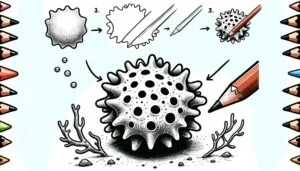How to draw a kitty, Kittens and cats have been a timeless source of artistic inspiration for centuries. Whether you’re an experienced artist or just starting out, drawing a kitty can be a fun and imaginative project. These adorable little ones provide a wonderful chance to refine your artistic abilities while capturing the elegance of cats. In this step-by-step guide, we’ll delve into the process of drawing a kitty, covering everything from the fundamentals of proportions to the intricate details that give each cat its own special charm.
Table of Contents
Materials You Will Need
Before we get started, make sure you have the necessary materials:
- Choosing between drawing paper or a sketchbook
- Pencils (H, HB, and 2B for shading)
- Eraser
- Blending tools like tortillons or blending stumps
- Reference images of felines (optional but helpful)
Step 1: Start with Basic Shapes
Begin by sketching the basic shapes that will form the kitty’s body. Use a gentle pencil and sketch a circle for the head and a basic oval for the body. These shapes are essential for establishing precise proportions.
Step 2: Define the Face
Sketch the kitty’s face, ensuring the proper positioning of the eyes, nose, and mouth. Keep in mind that feline features have a unique charm, characterized by their almond-shaped eyes, a small triangular nose, and an adorable little mouth.
Step 3: Add Ears and Tail
Kitties have cute little ears that come in all different shapes and sizes. Add two pointed ears on top of the head. Enhance the body with a gracefully curved tail. The length of the tail can vary depending on the breed of the cat, ranging from long and flowing to short and stubby.
Step 4: Create Fur Texture
Capturing the texture of fur is crucial in showcasing the defining feature of cats. Use delicate, light strokes to create a soft texture for the body. Take note of the fur’s direction, typically flowing from the head towards the tail.
Step 5: Detail the Eyes and Whiskers
The eyes of a cat are truly mesmerizing. Include the young students and a smaller circle for the centers of the eyes. You can adjust the eyes to create different expressions for the kitty. Remember to add the whiskers that come out from the sides of the face.
Step 6: Shade and Add Depth
Experiment with various pencils to create depth and dimension in your artwork. Cats frequently have darker patches of fur around their eyes, below their nose, and under their chin. The shading adds depth and dimension to your drawing.
Step 7: Final Details and Highlights
Take a moment to review your artwork and make any necessary tweaks. Enhance the eyes, nose, and fur to give the kitty a vibrant appearance. This step can make your drawing more vibrant and animated.

Tips for Success
Explore Study Reference Images: Delving into a collection of images showcasing cats, whether they are real-life photographs or illustrations from cartoons, can greatly enhance your understanding of cat anatomy, expressions, and the intricate patterns of their fur.
Try out different styles: You have the freedom to create drawings of cats in a wide range of artistic styles, whether it’s realistic and intricate or adorable and animated. Customize your approach to suit your artistic preferences.
Practice Proportions: Understanding the proportions of a feline’s body is essential for achieving accuracy. Continue honing your artistic abilities by consistently practicing the fundamental shapes and proportions.
Varied Fur Textures: Each cat breed possesses its own unique fur texture. Take the time to research the breed you’re drawing in order to accurately capture their unique fur patterns.
Enjoyment is key: Drawing adorable feline creatures should be a source of fun. Encourage self-expression and embrace your creative side. Every drawing of a cat can have its own unique personality.
FAQ: How to Draw a Kitty
I’m not a full-time artist. Can I still make a cat drawing?
Absolutely! The goal of this step-by-step manual was to make it simple for artists of all experience levels, even beginners, to follow. Anyone can have fun and express their creativity by drawing a cat.
Should I design a kitty using a reference photo?
It might be very beneficial to use a reference image, especially if you want to accurately depict a particular breed or position. It offers a graphic representation of traits, dimensions, and fur patterns. However, you might also use your creativity or prior knowledge to draw a cat.
What if I have trouble capturing the face features accurately?
It might be difficult to draw facial features like the eyes, nose, and mouth. Studying and practicing cat anatomy are vital. You can better comprehend the dimensions and intricacies by using reference pictures of cat faces.
Are there certain methods for depicting various cat breeds?
Different cat breeds have unique traits and fur patterns. To accurately represent a particular breed when drawing it, learn about its characteristics and fur textures. It all comes down to paying attention to the small print.
Is it possible to draw a cat in several ways, such as a realistic one or a cuddly, cartoonish one?
Absolutely! You can draw cats in a variety of ways, from charming and cartoonish to realistic and detailed. Your drawing’s mood and creative preferences can both be reflected in your style.
How can I create realistic and textured fur?
Pay attention to the texture and direction of the fur to make it look natural. Make sure the strokes mimic the fur’s natural flow, which is typically from the head down to the tail. Use short, delicate strokes to simulate the fur. Try with different pressures and hues to provide texture and depth.
Can I create a digital drawing of a cat using a drawing tablet or computer?
Certainly! Using graphic design software, drawing tablets, or smartphone apps, you can create a digital drawing of a cat. Digital drawing offers versatility, simple edits, and the chance to try out various coloring schemes.
How much time does it take to draw a cat?
Depending on your degree of skill and the amount of detail you want to include, drawing a cat can take a certain amount of time. A quick sketch could take 30 to 60 minutes, whereas a complex colored drawing might take eight hours or more.
What if I’m not happy with the cat drawing I made?
Don’t give up if you’re not happy with your drawing. Drawing is a skill that becomes better with use. Continue drawing cats, ask for critiques, and work to improve your abilities.
What books or websites can I use to learn more about sketching cats?
To learn how to draw cats and other animals in general, there are a lot of books, online tutorials, and courses accessible. To improve your knowledge, look for publications that discuss the anatomy, facial expressions, and fur patterns of cats.
Conclusion
A cat drawing is a great method to practice your artistic skills and portray the allure of these lovely animals. Keep in mind that there are no right or wrong ways to draw a cat, and that each drawing can be as distinctive as the feline model you use. So, grab some pencils, let your creativity run wild, and set out on an artistic adventure that will surely melt your heart. Happy sketching!





